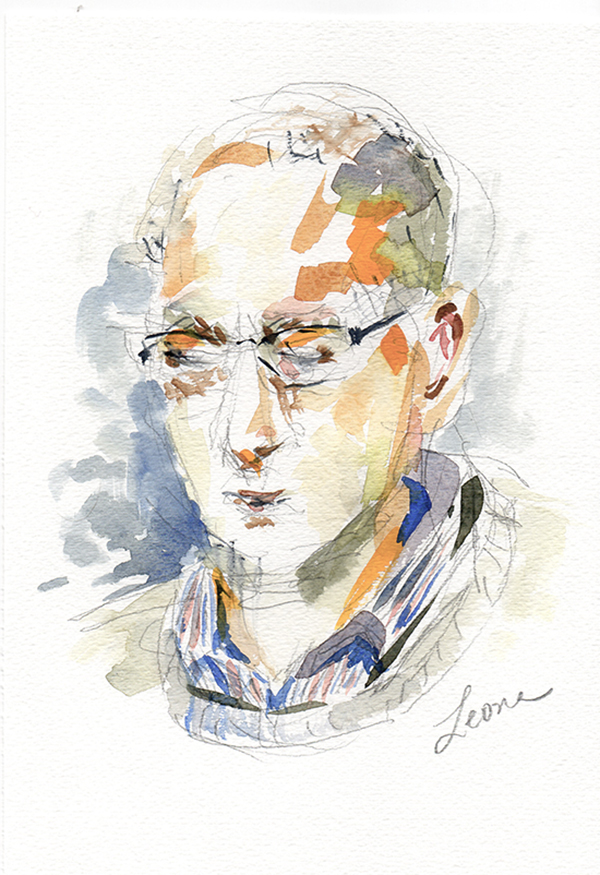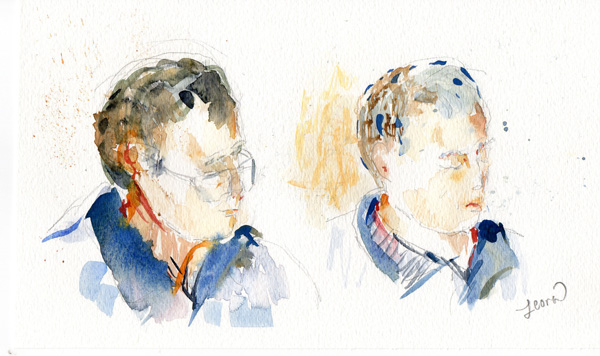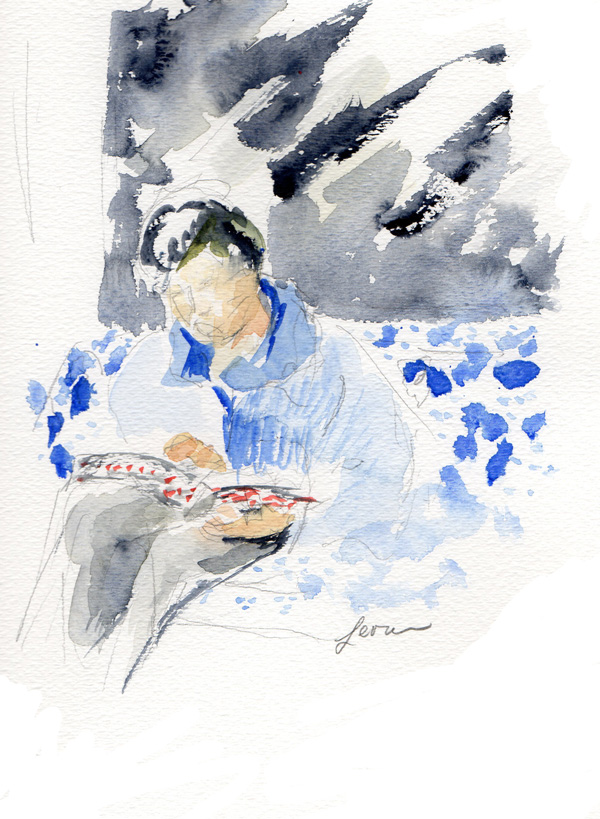
I did several watercolor paintings of this exercise: ” “Use a graphite pencil to draw a few lines … do notice the lighting hitting the face… Take your watercolor and add a few large shapes. Let dry; add other colors on top…play with different color and texture combinations.” I posted three of them in reverse order of when I did them (I did the bottom one first). Watercolor exercise is from the book One Watercolor a Day.

All of the remaining three portraits on this page are different depictions of my husband. The top one is not – he was a visiting friend. Our friend liked his portrait so much that he asked if he could keep it. So I scanned it into the computer and then presented the watercolor to him. Wonder if he will hang it in his office?

This is the first one I did – it has the least amount of color. Plus, I realized the exercise was really a portrait, and I had done the whole figure. What I really want to focus on here, in this bottom watercolor, is the book. Do you see the splatters of red paint along the spine? This book is a chumash (one of the five books of the Torah). It happens to be part of an edition of volumes that was presented to my father z”l as part of being honored by the Highland Park Kollel. That gives it special meaning, and I am happy to see my husband using that volume as part of his weekly learning.
I think I will do more watercolor portraits. By the way, if you come visit on a Sunday or weekday and start to read a book or your laptop, I might take out my paints, pencils and watercolor paper and start to paint you. You have been warned.

I was in the mood to post a cheery photo, and here’s a great one of the daughter and me. I don’t recall who took the photo; it was a year and a half ago on Purim, a holiday where kids get dressed up, and my daughter was dressed as a Prima Ballerina. It was taken at our synagogue, Congregation Etz Ahaim of Highland Park, New Jersey.
I made this sepia in Photoshop by desaturating the photo and then moving the color sliders to increase the yellow and magenta. For more information see Sepia Scenes.


Some of you enjoyed seeing my portrait posted, so here’s another one. If you’ll click on the photo, you’ll see the boy that I’m missing. I dropped him off yesterday so he could head off to camp for a month. He’s sure he’ll love it (Camp Stone), but I’m sure I’ll miss him. He’s my creative youngster, the one who was in the local teen film festival (shh, he’s only 11). On an aside, Michelle Reasso is back part-time at the Highland Park Public Library, so hopefully, there will be a new teen film festival this winter.
The photo was taken in the mirrored elevators of the King’s Hotel in Jerusalem. At some point, I will do a post on their “swimming pool” (they don’t really have one, it’s not the ritziest place in town), but it will be a fun post about an interesting city element with a Paris connection.
While I was driving my son from Highland Park, New Jersey to Teaneck, New Jersey, I asked my boy to take a few photos. Not because there is great scenery on the New Jersey Turnpike. It’s more like a nightmarish view, what gives New Jersey a bad name. I haven’t even looked at the photos yet; they are still in my camera, but maybe I’ll get up the guts to post a few, and submit something to Sky Watch Friday? As a contrast to all the beautiful sky photos from around the world one can find there.
Lion of Zion said he posted for a year about his trip to Israel, so I feel better about doing so here. Stay tuned for more postings about food in Israel, as Lion of Zion raised the topic of restaurants.
And just to add yet one more topic to this eclectic post, if anyone has any good thoughts on alternative energy research, would love to hear.
From sad portraits of Jews to intricate mosaics, Ilana Shafir has created many works of art. I had the pleasure of attending a Highland Park Arts Commission lecture Thursday night (thanks, Jill, for getting me out of the house) where Ilana spoke to a full audience.
Ilana was born in Sarajevo, Yugoslavia. She always wanted to study art formally, but as a teenager there was no opportunity. Then the Nazis invaded. Her family managed to escape to a little village called Kula, where she drew portraits of the villagers. When asked how she managed to get art supplies during the war, she replied: “It was a miracle.” After the war, she studied at the Art Academy of Zagreb. In 1949 she made Aliyah (moved to Israel). She settled in Ashkelon, where she still lives today, with a garden full of her mosaics and her whimsical ceramic creatures.
In order to find models for her portraits in her early days in Israel, she went to the local “ma’abara” (transit camp) and created sketches, paintings and prints of the exotic (to her European eyes) residents from Yemen, North Africa, and other areas of the world where Jews had left to come to Israel. I was disappointed that these lovely portraits as well as earlier ones from her European days, which she showed us in her slide show, are not on her website.
At some point someone said to her: “Who is going to hang portraits of sad Jews in their museum?” Around the same time she developed an allergy to turpentine. At first she wore gloves, but this was not enough. She told us a funny aside, that on Purim, when the kids dressed up as artists in Ashkelon, they wore gloves!
Her art style switched to fantastic ink and watercolor paintings, ceramic creatures, and finally, the medium she loves the most, mosaic. She told us it takes 6-7 months for her to complete a mosaic. Talk about stamina and drive.
If you are in Ashkelon, her mosaics are on display in various public places, including a syngagogue, where her mosaic of Jerusalem has the names of family members who perished in the Holocaust and a “Z”, standing for the star Jews had to wear in Sarajevo during the war. Other Jewish themes are the Burning Bush (shown under her photo on this post) and the Tree of Life (with one tree on top of another, each generation has its roots in the former generation, she explained).
The presentation was an introduction by her daughter, a talk by Ilana with slide show, and a short movie by her son, Giora. Learn more: http://www.shafirart.com/
Menachem Wecker just posted an interview we did over email on his blog, Iconia. I really enjoyed answering his questions; the connection between Judaism and art for me brings up many issues, struggles, joys.


This is the only finished artwork I have of one of my children that was done completely from real life. It is considered preferable to paint or draw from a real subject, as opposed to using a photograph. But how does one get a child to sit still, even for five minutes? This son in particular was an extremely busy four-year-old, the age he was when I did this drawing. So I captured him asleep. And as one of his teachers reminded me recently, he still has a hard time sitting still.

This a picture of my mom, z”l (may her memory be a blessing), posing in front of some fancy shop in Newton Centre. We used to enjoy window shopping together. I took the photo in the late 1970’s? early 80’s? It captures a little of her personality.

my latest watercolor













